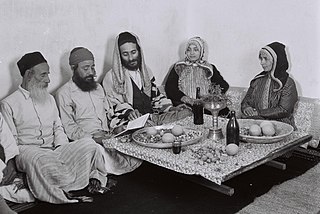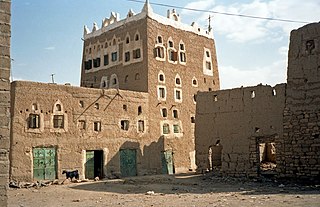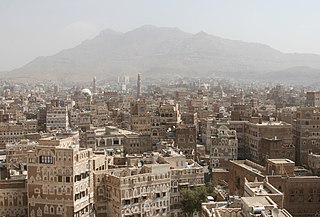
The history of Yemen describes the cultures, events, and peoples of what is one of the oldest centers of civilization in the Near East. Its relatively fertile land and adequate rainfall in a moister climate helped sustain a stable population, a feature recognized by the ancient Greek geographer Ptolemy, who described Yemen as Eudaimon Arabia meaning "fortunate Arabia" or "Happy Arabia". Yemenis had developed the South Arabian alphabet by the 12th to 8th centuries BC, which explains why most historians date all of the ancient Yemeni kingdoms to that era.

Yemenite Jews, also known as Yemeni Jews or Teimanim, are those Jews who live, or once lived, in Yemen, and their descendants maintaining their customs. Between June 1949 and September 1950, the overwhelming majority of the country's Jewish population immigrated to Israel in Operation Magic Carpet. After several waves of persecution, the vast majority of Yemenite Jews now live in Israel, while smaller communities live in the United States and elsewhere. As of 2022, Levi Marhabi is the last Jew in Yemen.

Yemen, officially the Republic of Yemen, is a country in West Asia. It is located in the southern end of the Arabian Peninsula, bordering Saudi Arabia to the north and Oman to the northeast. It shares maritime borders with Eritrea, Djibouti and Somalia. Covering 530,000 square kilometres and having a coastline of approximately 2,000 kilometres, Yemen is the second-largest Arab sovereign state on the Arabian Peninsula. Sanaa is its constitutionally stated capital and largest city. The country's population is estimated to be 34.7 million as of 2023. Yemen is a member of the Arab League, the United Nations, the Non-Aligned Movement and the Organisation of Islamic Cooperation.

Islam in Yemen dates back to about 630AD, when it was introduced by Ali who finalized the conquest of it when Muhammad was still alive. It was during this period that the mosques in Janad and the Great Mosque of Sana'a were built. Yemenis are divided into two principal Islamic religious groups: 65% Sunni and 35% Shia. Others put the numbers of Shias at 30%. The denominations are as follows: 65% primarily of the Shafi'i and other orders of Sunni Islam. 33% of the Zaidi order of Shia Islam, 2% of the Ja'fari and Tayyibi Ismaili orders of Shia Islam. Yemen is home to the Sulaymani Bohra community, a subdivision of Tayyibi Mustali Ismailism. The Sunnis are predominantly in the south and southeast. The Zaidis are predominantly in the north and northwest whilst the Jafaris are in the main centres of the North such as Sana'a and Ma'rib. There are mixed communities in the larger cities.

Saada, a city and ancient capital in the northwest of Yemen, is the capital and largest city of the governorate of the same name, and the seat of the district of the same name. The city is located in the mountains of Serat (Sarawat) at an altitude of about 1,800 meters. In 2004, it was the tenth-largest city in Yemen and had an estimated population of 51,870.

Christianity is a minority religion in Yemen. The Yemeni constitution mentions religious liberty. There are three churches in Aden.

The history of the Jews in the Arabian Peninsula dates back to Biblical times. The Arabian Peninsula is defined as including the present-day countries of Bahrain, Kuwait, Oman, Qatar, Saudi Arabia, United Arab Emirates and Yemen politically and parts of Iraq and Jordan geographically.
The Constitution of Yemen provides for freedom of religion, and the Government generally respected this right in practice; however, there were some restrictions. The Constitution declares that Islam is the state religion, and that Shari'a is the source of all legislation. Government policy continued to contribute to the generally free practice of religion; however, there were some restrictions. Muslims and followers of religious groups other than Islam are free to worship according to their beliefs, but the Government prohibits conversion from Islam and the proselytization of Muslims. Although relations among religious groups continued to contribute to religious freedom, there were some reports of societal abuses and discrimination based on religious belief or practice. There were isolated attacks on Jews and some prominent Zaydi Muslims felt targeted by government entities for their religious affiliation. Government military reengagement in the Saada governorate caused political, tribal, and religious tensions to reemerge in January 2007, following the third military clash with rebels associated with the al-Houthi family, who adhere to the Zaydi school of Shi'a Islam.

Christianity is the largest religion in Botswana. However, the country is officially secular and allows freedom of religious practice.

Sanaa, also spelled Sana'a and Sana, is the capital and largest city of Yemen and the capital of the Sanaa Governorate. The city is not part of the Governorate, but forms the separate administrative district of ʾAmānat al-ʿĀṣimah. According to the Yemeni constitution, Sanaa is the capital of the country, although the seat of the Yemeni government moved to Aden, the former capital of South Yemen in the aftermath of the Houthi occupation. Aden was declared as the temporary capital by then-president Abdrabbuh Mansur Hadi in March 2015.
Topics related to Yemen include:

Abdul-Malik Badruldeen al-Houthi, also known as Abi Jibril, is a Yemeni politician and religious leader who serves as the leader of the Houthi movement, a revolutionary movement principally made up of Zaidi Muslims. His brothers Yahia and Abdul-Karim are also leaders of the group, as were his late brothers Hussein, Ibrahim, and Abdulkhaliq. Abdul-Malik al-Houthi is the leading figure in the Yemeni Civil War which started with the Houthi takeover in Yemen in the Saada Governorate in northern Yemen.

The siege of Dammaj began in October 2011 when the Houthis, a Zaydi-led rebel group which controls the Sa'dah Governorate, accused Salafis loyal to the Yemeni government of smuggling weapons into their religious center in the town of Dammaj and demanded they hand over their weapons and military posts in the town. As the Salafis refused, Houthi rebels responded by imposing a siege on Dammaj, closing the main entrances leading to the town. The town was controlled by the Houthis and the fighting was mainly centered at Dar al-Hadith religious school, which was operated by Salafis.

The following lists events that happened in 2015 in Yemen.

The Yemeni crisis began with the 2011–2012 revolution against President Abdullah Saleh, who had led Yemen for 33 years. After Saleh left office in early 2012 as part of a mediated agreement between the Yemeni government and opposition groups, the government led by Saleh's former vice president, Abdrabbuh Mansur Hadi, struggled to unite the fractious political landscape of the country and fend off threats both from Al-Qaeda in the Arabian Peninsula and from Houthi militants that had been waging a protracted insurgency in the north for years.

The Battle of Sanaa in 2014 marked the advance of the Houthis into Sanaa, the capital of Yemen, and heralded the beginning of the armed takeover of the government that unfolded over the following months. Fighting began on 9 September 2014, when pro-Houthi protesters under the command of Abdul-Malik al-Houthi marched on the cabinet office and were fired upon by security forces, leaving seven dead. The clashes escalated on 18 September, when 40 were killed in an armed confrontation between the Houthis led by military commander Mohammed Ali al-Houthi and supporters of the Sunni hardliner Islah Party when the Houthis tried to seize Yemen TV, and 19 September, with more than 60 killed in clashes between Houthi fighters and the military and police in northern Sanaa. By 21 September, the Houthis captured the government headquarters, marking the fall of Sanaa.

Yemenite Jews in Israel are immigrants and descendants of the immigrants of the Yemenite Jewish communities, who now reside within the state of Israel. They number around 400,000 in the wider definition. Between June 1949 and September 1950, the overwhelming majority of Yemen and Aden's Jewish population was transported to Israel in Operation Magic Carpet.

The Islamic State – Yemen Province is a branch of the militant Islamist group Islamic State (IS), active in Yemen. IS announced the group's formation on 13 November 2014.

In the early years before the immigration to Israel, the Jewish community of Saada numbered around 1000 people.

Shia Islam in Yemen is practiced by a substantial minority of the population, with the vast majority of Shia Muslims in Yemen being Zaydi, while a minority are Twelver and Isma'ili. Sunni Muslims make up 65% percent of Yemen, while 35% of the country are Shia Muslims. These Shia Muslims are predominantly concentrated in the northwestern regions of the country, including the capital and major cities that are some of the most densely populated areas of Yemen.























